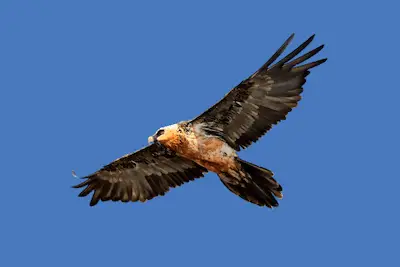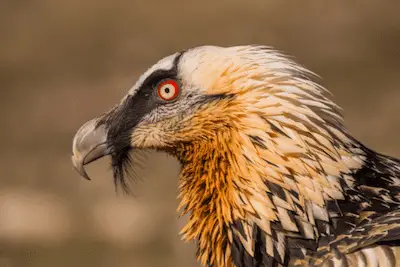Bearded Vulture
(Gypaetus barbatus)
The Bearded Vulture is one of the largest raptors in Europe, but at the same time also the rarest, which makes it a precious part of our natural heritage and a symbol of nature conservation.

In spite of its massive wingspan, the Bearded Vulture flies with surprising elegance as it soars in the thermal currents of mountain ranges, and patrols ridges and valleys for fresh carrion.
The Bearded Vulture faces many threats, being close to extinction in several isolated parts of its range, and was actually driven to extinction in the Alps.
However, a highly successful reintroduction effort in the Alps has restored a breeding population there, and this has kindled renewed hope for the future of this species.
Bearded Vulture facts
With a wingspan of almost 3 meters, the Bearded Vulture is one of the largest birds in Europe. And due to its rarity, it has become a symbol of wildlife conservation.
Bearded Vulture size
Below are the average size measurements of the Bearded Vulture:
- Bearded Vulture wingspan: 250-290 cm
- Length: 99-113 cm
- Weight: 4,500-7,150 g
In spite of its large size, this bird flies with astonishing agility, soaring and gliding elegantly over mountain ridges and mountain passes.
Appearance
The Bearded Vulture is a very large vulture with a surprisingly elegant profile during flight, due to its long slender wing, combined with the long, diamond shaped tail.

Lifespan
The Bearded Vulture can live up to 45 years in captivity, but it’s not known how long it lives in the wild.
Scientific name and taxonomy
The scientific name of the Bearded Vulture is Gypaetus barbatus. There are two subspecies: G. b. barbatus (in Northwestern Africa and Southwestern Europe), and G. b. meridionalis (in Southwestern Arabia, Eastern Africa, and South Africa).
Bearded Vulture distribution
While the G. b. Barbatus subspecies has a relatively small distribution range in southern Europe and northern Africa, the second subspecies (G. b. meridionalis) covers a much larger area with its range.
Bearded Vulture habitat
The Bearded Vulture lives almost exclusively in high mountain zones, and spends most of its time foraging above the tree line. However, juvenile birds are sometimes encountered far away from mountains.
Bearded Vulture population size
The European population of the Bearded Vulture is relatively small, estimated to number less than 1,000 breeding pairs.
However, this represents an increase from previous decades, when the population size was even lower, due to relentless persecution over the past centuries. Fortunately, the population now seems to be stable.
Bearded Vulture behavior
The Bearded Vulture searches for food by soaring to high altitudes over mountain gorges and ridges, while scanning the ground below for carrion. Sometimes it can be seen hovering in position over a cliff or ridge.
Feeding and diet
The Bearded Vulture is the only European raptor that regularly feeds on the bones and bone marrow of dead animals. This specialization reduces its competition with other vultures and carrion birds.
In addition to feeding on animal carcasses, this raptor sometimes also attacks live animals, such as rock hyraxes and ibex goats.
Breeding
Of all European Raptors, the Bearded Vulture takes longest to reach sexual maturity, and doesn’t start breeding until it’s 6 to 8 years old. Eggs are laid very early in the season, and can be deposited as early as late December, and continuing until early February.
This strategy ensures there will be plenty of food for the chick after it hatches, since the melting of the snow reveals the carcasses of dead animals. While these birds of prey usually lay two eggs, only one chick survives since the first born chick always kills its younger sibling.
Migration
The Bearded Vulture is a partial migrant, with adult birds thought to be mostly resident, staying close to their breeding grounds all year long. Juvenile birds, on the other hand, are well known for their movements, and this explains why they often show up in areas that are not normally part of the Bearded Vulture’s habitat.
Bearded Vulture conservation status
While the Bearded Vulture is common in many parts of its large range, it is much more vulnerable in the European part of its distribution, where it is one of the rarest raptors, and is considered “Near Threatened.”
Indeed, the population of these birds in the alps was completely extinct by the early 2000’s, but has since been successfully reintroduced. Currently, the small isolated populations in Corsica and Crete are at highest risk of extinction, since they consist of only a handful of breeding pairs.
Threats
The most serious threat to Bearded Vultures is illegal poisoning from poisoned carcasses, which are sometimes used by humans to kill wolves. However, direct persecution has been dramatically reduced over the past decades, which provides reason for cautious optimism.
Additional resources:
- Egyptian Vulture distribution and habitat
- Cinereous Vulture facts
- Eurasian Griffon Vulture conservation status
